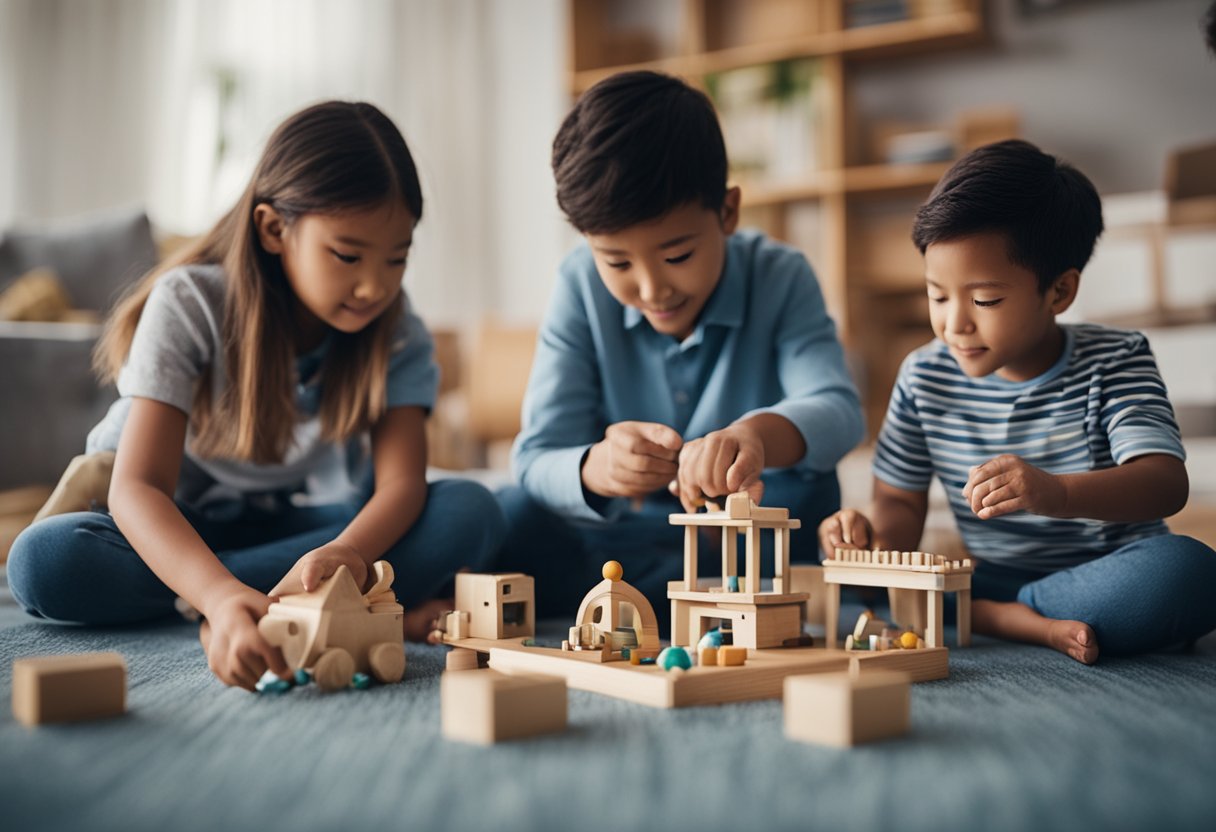Disciplining a toddler can be a challenging task for any parent or caregiver. Toddlers are at a stage where they are learning about the world around them and testing boundaries, which can lead to misbehavior.
It is important to understand that discipline is not about punishment, but about teaching your child appropriate behavior and helping them develop self-control and social skills.

Understanding toddler behavior is the first step in effective discipline. Toddlers are still developing their communication skills and may resort to hitting, biting, or throwing tantrums when they are frustrated or upset.
As a parent or caregiver, it is important to remain calm and patient while addressing the behavior. By using positive reinforcement, setting clear boundaries, and redirecting their attention, you can help your toddler learn appropriate behavior and avoid future misbehavior.
Key Takeaways on How to Discipline a Toddler
- Understanding your toddler’s behavior is key to effective discipline.
- Positive reinforcement, clear boundaries, and redirection are effective strategies for managing misbehavior.
- Consistency and patience are important in teaching your toddler appropriate behavior.
Check out these other top posts on this category:
- Why Does My Baby Hate Me?
- 3 Year Old Behavior
- Understanding Why Your Child May Feel Jealous of Your Affection
Understanding Toddler Behavior
As a parent, it’s essential to understand your toddler’s behavior to discipline them effectively. Toddlers are at a stage of rapid cognitive and physical development. They are curious and eager to explore their surroundings, but they lack the cognitive ability to understand the consequences of their actions fully.
According to the American Academy of Pediatrics, toddlers’ behavior is often challenging because they are still developing their communication and social skills. They may resort to crying, screaming, or throwing tantrums to express their frustration or get their way. It’s crucial to remember that this behavior is normal and developmentally appropriate.
It’s also important to note that toddlers have a short attention span, and their behavior can change quickly. They may be happy and content one moment and upset and crying the next. As a parent, it’s essential to remain calm and patient when dealing with your toddler’s behavior.
To understand your toddler’s behavior better, it’s helpful to observe and take note of their actions. For example, you may notice that your toddler throws a tantrum when they are hungry or tired. By identifying these triggers, you can take steps to prevent them from happening in the future.
Understanding toddler behavior is crucial to effective discipline. Toddlers are developmentally appropriate, curious, and eager to explore their surroundings. They may resort to crying or throwing tantrums to express their frustration, and their behavior can change quickly.
As a parent, it’s essential to remain calm and patient and observe your toddler’s behavior to identify triggers and prevent future outbursts.
Strategies for Managing Biting and Hitting
As a parent, dealing with a toddler’s aggressive behavior can be challenging. Biting and hitting are common behaviors in toddlers, but they can be dangerous and harmful. Here are some effective discipline strategies to manage biting and hitting in toddlers:
1. Redirect and Distract
When your toddler bites or hits, it’s important to respond immediately. One effective strategy is to redirect and distract your toddler’s attention. For example, if your toddler bites you, say “No biting, biting hurts” in a firm but calm tone, and then offer them a toy or a snack to distract them from biting again.
2. Positive Reinforcement
Positive reinforcement is a powerful tool for shaping your toddler’s behavior. When your toddler demonstrates positive behavior, such as sharing or playing nicely, praise and reward them. This will reinforce the desired behavior and encourage them to repeat it.
3. Use Clear and Consistent Discipline Strategies
Consistency is key when it comes to disciplining toddlers. Make sure you use clear and consistent discipline strategies, such as time-outs or loss of privileges, when your toddler bites or hits. This will help them understand that their behavior is not acceptable and has consequences.
4. Understand the Root Cause of the Behavior
It’s important to understand why your toddler is biting or hitting. Sometimes, it’s a sign of frustration or a lack of communication skills. If your toddler is struggling with language development, it’s important to work with them to improve their communication skills.
Managing biting and hitting in toddlers can be challenging, but with the right discipline strategies, you can effectively redirect their behavior and encourage positive behavior. Remember to stay calm, be consistent, and understand the root cause of the behavior.
Potty Training Tips and Tricks
Potty training is one of the most challenging tasks that parents face when raising toddlers. As a parent, I have learned a few tips and tricks that can make the process easier for both you and your child. Here are some of my recommendations:
1. Start at the Right Time
It is important to start potty training at the right time. Most children are ready to start potty training between the ages of 2 and 3 years old. However, every child is different, and some may be ready earlier or later than others. It is important to watch for signs that your child is ready, such as showing an interest in the potty or having dry periods during the day.
2. Be Patient
Potty training takes time and patience. It is important to remain calm and patient with your child throughout the process. Remember that accidents will happen, and it is important not to get frustrated or angry with your child. Instead, offer encouragement and support.
3. Offer Choices
Giving your child choices can help them feel more independent and in control of the process. For example, you can let your child choose which potty chair they want to use or which underwear they want to wear. This can make the process more fun and engaging for your child.
4 Consistency is Key
Consistency is key when it comes to potty training. It is important to establish a routine and stick to it. For example, you can have your child sit on the potty at regular intervals throughout the day, such as after meals or before nap time. This can help your child get into the habit of using the potty.
5. Set Realistic Expectations
It is important to set realistic expectations when it comes to potty training. Remember that every child is different, and some may take longer than others to learn. Don’t put too much pressure on your child, and celebrate every small success along the way.
6Use Consequences
Using consequences can be an effective way to encourage your child to use the potty. For example, you can offer a small reward, such as a sticker or a piece of candy, every time your child successfully uses the potty. On the other hand, you can take away a privilege, such as screen time, if your child has an accident.
Potty training can be a challenging process, but with patience, consistency, and a positive attitude, it can be a success. Remember to be patient and offer choices, set realistic expectations, and use consequences when necessary.
Encouraging Good Sleep Habits
As a parent of a toddler, I know how important it is to establish good sleep habits. Toddlers need between 11-14 hours of sleep a day, including naps, to help them stay healthy and develop properly. However, getting your toddler to sleep can be a challenge. Here are some tips for encouraging good sleep habits:
Set a Consistent Bedtime Routine
Setting a consistent bedtime routine is essential for encouraging good sleep habits. Toddlers thrive on routine and predictability, so establishing a consistent bedtime routine can help them feel calm and relaxed.
A bedtime routine can include a bath, reading a story, and singing a lullaby. By following the same routine every night, your toddler will come to associate these activities with sleep and feel more comfortable and secure.
Establish Boundaries
Establishing boundaries around your toddler’s bedtime can help them understand what is expected of them. Let your toddler know that it is time for bed and that they need to stay in their bed until morning.
If your toddler gets out of bed, calmly and firmly guide them back to their bed. By setting these boundaries, you are teaching your toddler that sleep is important and that they need to respect their bedtime.
Avoid Overtiredness
Overtiredness can make it difficult for toddlers to fall asleep and stay asleep. Make sure your toddler is getting enough sleep during the day, and that they are not staying up too late at night. If your toddler is showing signs of being overtired, such as being irritable or hyperactive, it may be time to adjust their sleep schedule.
Create a Relaxing Environment
Creating a relaxing environment in your toddler’s bedroom can help them fall asleep and stay asleep. Make sure their bedroom is cool, quiet, and dark. Consider using a white noise machine to help drown out any outside noises. Soft, comfortable bedding and a favorite stuffed animal or blanket can also help your toddler feel more relaxed and secure.
Be Consistent
Consistency is key when it comes to encouraging good sleep habits. Stick to your toddler’s bedtime routine, and be consistent in your approach to bedtime. If your toddler knows what to expect, they will be more likely to go to bed without a fuss. By following these tips, you can help your toddler establish good sleep habits that will benefit them for years to come.
Mealtime with toddlers can be challenging, but with a few strategies, it can be a positive experience for everyone. Hunger is a common cause of frustration for toddlers, so it is essential to ensure that they are not too hungry or too full before mealtime. Offering small snacks throughout the day can help keep hunger at bay and prevent meltdowns at mealtime.
Distractions can also be a problem during mealtime. It is best to limit distractions such as toys, electronics, or other activities during mealtime. Instead, focus on the food and the family time. Encourage conversation and make mealtime a pleasant experience for everyone.
Patience is key when dealing with picky eaters. Toddlers may not be willing to try new foods, and that is okay. It may take several attempts before they are willing to try something new. It is important to offer a variety of foods and allow them to make choices about what they want to eat.
Offering choices can help toddlers feel empowered and more willing to try new things. For example, instead of asking, “What do you want for dinner?” offer two or three options and let them choose. This helps them feel like they have some control over the situation and can make mealtime less stressful.
In conclusion, mealtime with toddlers can be challenging, but with patience, choices, and a positive attitude, it can be a pleasant experience for everyone. By limiting distractions, offering small snacks throughout the day, and allowing them to make choices, mealtime can be a time for family bonding and exploration of new foods.
The Role of Consistency in Discipline

As a parent, I have learned that consistency is key when it comes to disciplining toddlers. Consistency means having a clear set of rules, expectations, and consequences that are consistently enforced. It is important to have consistent discipline to ensure that your toddler understands what behaviors are acceptable and what behaviors are not.
When setting rules, it is important to keep them simple and age-appropriate. Toddlers have limited attention spans and can become overwhelmed by too many rules. It is also important to explain the reasons behind the rules to help your toddler understand why they are important.
Consistent consequences are also essential to effective discipline. When your toddler breaks a rule, it is important to follow through with an appropriate consequence every time. This helps your toddler understand that their actions have consequences and reinforces the importance of following the rules.
Having consistent boundaries is also important. Toddlers need to know what is expected of them and what they can and cannot do. This helps them develop self-control and understand their own limits.
Consistency is a crucial component of effective discipline. It helps toddlers understand what is expected of them and reinforces the importance of following rules and boundaries. By setting clear rules and consequences and consistently enforcing them, parents can help their toddlers develop self-control and make positive choices.
Teaching Sharing and Cooperation

Teaching a toddler how to share and cooperate can be a challenging task, but it’s an essential part of their development. As a parent, I have found that the following strategies have been effective in teaching my child how to share and cooperate with others.
Communication and Praise
Communication is key when it comes to teaching a toddler how to share and cooperate. I always make sure to explain to my child why it’s important to share and how it can make others feel happy. I also praise my child when they do share and cooperate with others. Positive reinforcement can go a long way in encouraging good behavior.
Responsibility and Consequences
It’s important to teach a toddler that sharing and cooperation come with responsibilities. I explain to my child that they have a responsibility to share their toys and to play nicely with others. I also explain that there are consequences if they don’t share or cooperate. For example, if they don’t share, they may not be able to play with their friends.
Modeling and Guiding
Modeling and guiding are also important when it comes to teaching a toddler how to share and cooperate. I make sure to model good behavior by sharing and cooperating with my child and others. I also guide my child by showing them how to share and cooperate in different situations.
Games and Activities
Games and activities can be a fun way to teach a toddler how to share and cooperate. For example, playing games that involve taking turns or sharing can help teach a child about sharing and cooperation. I also encourage my child to play with others and to work together on activities.
In conclusion, teaching a toddler how to share and cooperate takes time and effort, but it’s an important part of their development. By using communication, responsibility, modeling, and games, parents can help their child learn these important skills.
Dealing with Public Tantrums

As a parent, dealing with public tantrums can be a daunting task. However, it is important to remember that tantrums are a normal part of a toddler’s development. Here are some strategies that I have found helpful in dealing with public tantrums:
1. Stay Calm: It is important to stay calm and composed during a tantrum. This helps to prevent the situation from escalating and can help to soothe your child.
2. Redirect Attention: Distraction can be a useful tool in dealing with tantrums. Try to redirect your child’s attention to something else. For example, you could point out something interesting in the environment or offer a toy or snack.
3. Be Patient: Tantrums can be frustrating, but it is important to be patient with your child. Remember that they are still learning how to regulate their emotions and behavior.
4. Remove Your Child from the Situation: If your child is having a particularly intense tantrum, it may be best to remove them from the situation. This can help to calm them down and prevent any further outbursts.
Dealing with public tantrums requires a combination of patience, redirection, and calmness. By following these strategies, you can help to manage your child’s behavior while also maintaining your own composure.
The Importance of Play and Downtime

As a parent, I have learned that toddlers need a lot of playtime and downtime. They have a lot of energy and curiosity, and it is important to provide them with opportunities to explore and learn. Playtime can be a great way to teach your child about the world around them, and it can also help them develop their social and emotional skills.
Additionally, downtime is crucial for toddlers. They need time to rest and recharge, just like adults do. When toddlers are overtired or overstimulated, they can become more prone to stressful situations and temper tantrums. By providing your child with regular downtime, you can help them manage their emotions and reduce their stress levels.
Research has shown that play and downtime are also essential for brain development. According to a study published in the journal Pediatrics, play is important for the development of cognitive, language, and social-emotional skills.
Downtime, on the other hand, allows the brain to process and consolidate new information, which can improve memory and learning.
As a parent, it is important to use positive reinforcement when encouraging your child to engage in play and downtime. For example, you could offer praise or a small reward when your child spends time playing with their toys or taking a nap. This can help your child develop a positive attitude towards play and downtime, which can benefit them in the long run.
Communication is also key when it comes to encouraging your child to engage in play and downtime. You can talk to your child about the importance of taking breaks and resting, and you can also encourage them to communicate their needs and feelings.
By fostering open communication, you can help your child develop healthy habits and coping mechanisms that will serve them well throughout their lives.
Frequently Asked Questions

How can I discipline my 3 year old who doesn’t listen?
Disciplining a 3-year-old who doesn’t listen can be challenging, but it’s important to remain calm and consistent. One effective method is to give your child choices, such as “would you like to put your toys away now or after dinner?”
This gives them a sense of control and can help avoid power struggles. It’s also important to set clear expectations and consequences for not following through. Remember to praise your child when they do listen and follow through.
What are some methods of discipline at home?
There are many methods of discipline that can be effective at home, including positive reinforcement, time-outs, natural consequences, and logical consequences. Positive reinforcement involves praising your child for good behavior, while time-outs involve temporarily removing your child from the situation.
Natural consequences involve allowing your child to experience the natural outcome of their behavior, while logical consequences involve imposing a consequence that is directly related to the misbehavior.
What is the best way to discipline a toddler who hits?
It’s important to address hitting behavior immediately and consistently. One effective method is to calmly and firmly tell your child that hitting is not allowed and that it hurts others. You can also redirect their attention to a different activity or remove them from the situation. It’s important to model appropriate behavior and avoid hitting your child as a form of discipline.
How do I discipline my 2 year old without hitting?
Disciplining a 2-year-old without hitting can be challenging, but there are many effective methods. One method is to use positive reinforcement, such as praising your child for good behavior.
Another method is to use time-outs, which involve temporarily removing your child from the situation. It’s important to set clear expectations and consequences for misbehavior, and to model appropriate behavior.
What are some effective punishments for a child?
Effective punishments for a child depend on the child’s age and the misbehavior in question. Some effective punishments include time-outs, loss of privileges, and natural or logical consequences. It’s important to avoid physical punishment, such as hitting or spanking, as it can be harmful and ineffective.
At what age should I start disciplining my toddler?
Discipline should begin as soon as your child is old enough to understand cause and effect. This can be as early as 6 months old, when a baby begins to understand that their actions have consequences.
It’s important to use age-appropriate discipline methods and to be consistent in your approach. Remember to praise your child for good behavior and model appropriate behavior yourself.

Iesha is a loving mother of 2 beautiful children. She’s an active parent who enjoys indoor and outdoor adventures with her family. Her mission is to share practical and realistic parenting advice to help the parenting community becoming stronger.
